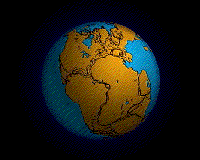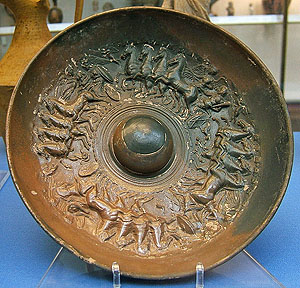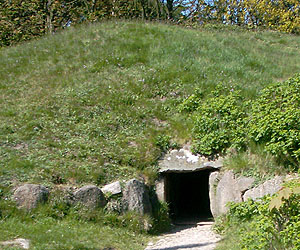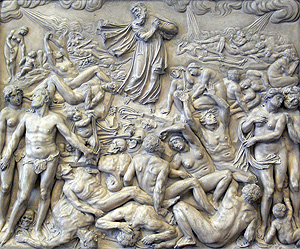Interpretation of the Dream
The rocky peninsula that rises out of the sea can refer far back as to a time long before the birth of man.

to the present positions of
the continents. USGS
SuperMarioBross99th
2013 commons.wikimedia
The super-continent Pangea grew from again older continental plates and existed between 300 and 150 million years ago, before it split up into our present continental plates. Pangea was surrounded by a single ocean, Panthalassa. In daily experience the Earth can appear ‘rock solid’. Yet she and the continental plates and rock strata are in constant motion. Earthquakes recall this continuous movement to memory.

horse-carriage and deities. Capanian
black-glazed ware, 4th-2nd century BC.
Calvi Risorta, Italy. British Museum,
London; GR 1839.11-9.37a.
AgTigress 2010 commons.wikimedia
Representations of a ‘Navel of the World’ - Greek ὀμφαλός, omphalos, navel stone - existed in many ancient cultures and still exist. They indicate subjective or ethnocentric centres of the world, to focus a worldview or life stance. At the same time, a navel refers to the place of origin, where one was attached to. In my experience, I stood on the belly of ‘Mother Earth’, who bore me and everything that lives on her. The rise and fall under my feet do remind me also of the movements of the earth above so-called super volcanoes, such as the Phlegraean Fields west of Naples in Italy and the Yellowstone Caldera in the Yellowstone National Park in the United States.

(Sylt Frisian for ‘Thing hill'),
passage grave, Wenningstedt, Sylt,
Schleswig-Holstein, Germany
Approximately 3000 B. C. MGA73
2009 commons.wikimedia
The dolmens in the Netherlands are attributed to the New Stone Age, from 3450 to 3259 B. C. However, they were used up until 2850 B. C. From archaeologists I learned that their builders understood them as uterus, as the womb of Mother Earth, which brings forth all life and takes it back in again. One patriarchal form of the original matriarchal experience could be the expression in the famous Book of Job in the Hebrew Bible, the so-called ‘Old Testament’ :
Naked I came from my mother's womb, and naked shall I return.
The Lord gave, and the Lord has taken away; blessed be the name of the Lord.
(Job 1.21 English Standard Version 2001; comp. Gen 3.19; Ps 139.15; Pr 5.14f etc.)

Vision of Ezekiel Alabaster Relief,
1640 - 1650, Sculpture Collection,
Bode-Museum Berlin. AndreasPraefcke
2007 commons.wikimedia
Many reports and stories in the Bible belong to the Bronze and Iron Ages. The Bronze Age began in the Middle East around 3000 B. C. and lasted until around 1200 B. C. In the Netherlands and in Belgium the Bronze Age set in about a thousand years later, around 2000 B. C. and lasted until around 800 B. C. The Iron Age began in the Levant around 1200 B. C. and in Belgium and the Southern Netherlands around 700 B. C. Even though in the Bronze and Iron Age one was already used to ‘bless’ a ‘male' deity for birth and death, in earlier and older matriarchal cultures a ‘female' deity, a goddess, or ‘the’ Goddess received the ‘blessing’. Similar to a vision of the prophet Ezekiel, graves do not necessarily have to be seen as the terminus of life. Grave and death can also be seen as a source of light and renewal; a view that took on various forms in human history.